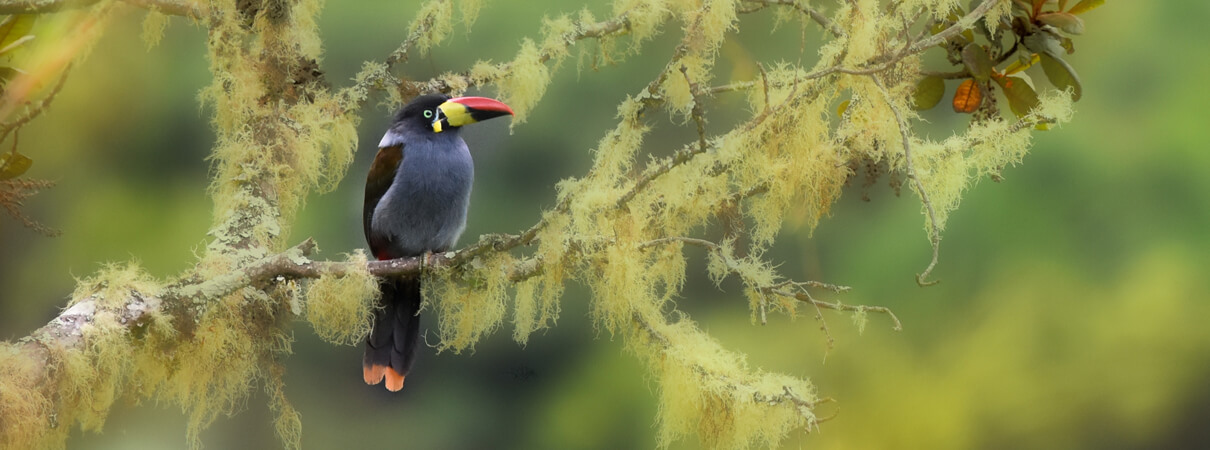 The colorful Gray-breasted Mountain-Toucan inhabits chilly, damp, mountainous terrain, unlike its larger lowland relatives the Channel-billed and Keel-billed Toucans. In fact, its genus name Andigena means "coming from the Andes Mountains" — a nod to this toucan's sloping habitat.
The colorful Gray-breasted Mountain-Toucan inhabits chilly, damp, mountainous terrain, unlike its larger lowland relatives the Channel-billed and Keel-billed Toucans. In fact, its genus name Andigena means "coming from the Andes Mountains" — a nod to this toucan's sloping habitat.
The Gray-breasted Mountain-Toucan can be differentiated from the three other mountain-toucan species by its red-, yellow-, and black-banded bill and, in one subspecies, its piercing yellow eyes.
Above the Rest
Most people associate toucans with hot, humid lowlands. Many of the approximately 40 toucan species do live in hot places, but there are also species in warm subtropical mountain forests. Higher up still are temperate habitats, particularly cloud forest, which is where you'll find Gray-breasted Mountain-Toucans.
This species lives at higher elevations than any other toucan, except perhaps the closely related Hooded Mountain-Toucan of Peru and Bolivia. Either way, the Gray-breasted Mountain-Toucan lives as high as a toucan can, in cool, rainy cloud forest between 7,500 and 11,000 feet elevation. Often, this bird is found at or near the treeline, where forest stops and open grassy or brushy páramo habitat begins.
Two subspecies have been identified, differing in eye color. Although this toucan is less vocal than some of its relatives, its nasal, ascending call is distinctive and carries far across the forest canopy. Have a listen:
(Audio by Fabrice Schmitt XC318761. Accessible at www.xeno-canto.org/318761)
Although nonmigratory, the Gray-breasted Mountain-Toucan sometimes ranges between altitudes, following the timing of fruiting trees.
Going to Ground
Like many tropical bird species such as the Andean Cock-of-the-rock and Banded Cotinga, the Gray-breasted Mountain-Toucan is frugivorous (fruit-eating), feasting on a wide variety of fruits and berries. It will also consume insects, small reptiles, and bird eggs, particularly during nesting season, when both adults and chicks need extra protein.
Gray-breasted Mountain-Toucans move quietly through the treetops, alone or in small groups, but may also descend to the ground in search of food — an unusual trait in this family of highly arboreal birds. They often associate with flocks of tanagers, thrushes, and blackbirds while foraging, which is also unusual for a toucan.
When flapping from one area to another in search of food, toucans fly in a loose, rather straggling line, not in a compact group, as do parrots such as Rusty-faced Parrots or Golden-plumed Parakeets.

Fruity Courtship
A male Gray-breasted Mountain-Toucan woos a potential mate by tossing her fruit. Courting birds also feed and preen each other to cement their pair bonds. Mated pairs nest high in the canopy, usually in an old woodpecker cavity, where the female lays three or four eggs. Both parents share equally in incubation duties and chick feeding.
Reserving Room for Mountain-Toucans
Although still locally common, the Gray-breasted Mountain-Toucan is considered Near Threatened by the International Union for Conservation of Nature (IUCN) — a result of habitat loss to agricultural development, unsustainable logging, and mining.
ABC helps partners protect habitat for Gray-breasted Mountain-Toucans at reserves in three countries: Tapichalaca and Yunguilla in Ecuador; Abra Patricia in Peru; and at a number of Colombian reserves that comprise the "Parrot Corridor," which also shelters the Yellow-eared and Fuertes' Parrots.
Donate to support ABC's conservation mission!



















































